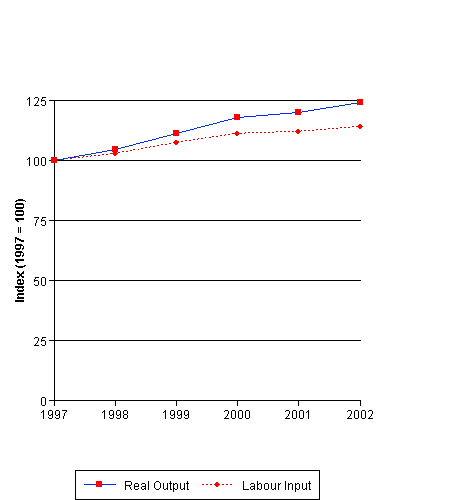| Français | Contact Us | Help | Search | Canada Site | ||||||
| Home | Site Map | What's New | About Us | Registration |
|
||||||

Labour Productivity
|
| Position in NAICS Hierarchy |
The sectors of the economy can be regrouped to form five largely goods-producing industries (NAICS 11 to 31-33) and fifteen service-producing industries (NAICS 41 to 91).
The 20 economic sectors specified by the North American Industry Classification System (NAICS) are listed below. Links are to the official NAICS Canada 2002 definition of each sector.
| Data Sources |
For the first time, Statistics Canada is publishing labour productivity data on the basis of the North American Industry Classification System (NAICS). The annual indices on productivity correspond with values from CANSIM Table 383-0013.Additional data on real output and labour input were obtained from CANSIM Table 383-0015.
| Understanding Labour Productivity |
Labour productivity is measured as real Gross Domestic Product (GDP) for every hour worked in Canada's business sector. Labour productivity derived from real GDP is presented as an index in order to avoid methodological problems associated with level comparisons.
The business sector excludes public administration, non-profit organizations and the Canadian System of National Accounts (CSNA) imputation of the rental value of owner-occupied dwellings. Corresponding exclusions are also made to compensation and hours worked. It is difficult to draw inferences on productivity from these sectors and they are therefore excluded. In 1992, the business sector GDP accounted for about 71% of the Canadian total.
Labour productivity measures the extent in which labour is efficiently used. An increase in labour productivity is associated with increases to real incomes and the standard of living for an economy.
Changes in labour productivity may result from changes in one or more of the following factors :
Labour productivity may fall if an industry does not adequately invest in the competence of its labour force, in modernizing its plants and factories, or in improving the efficiency of its operations.
An alternative measure of labour productivity is calculated for the Manufacturing sector and its subsectors, industry groups, industries and national industries in the performance chapter. This measurement is calculated as manufacturing value-added divided by the number of hours worked by production workers. The calculation is presented as a level in current dollars. However, 1999 is the most recent reference period, as production hours are no longer surveyed in the Annual Survey of Manufactures.
| Labour Productivity Index |
The graph below illustrates changes in labour productivity for the business sectors of the Canadian Economy between 1997 and 2002.

Between 1997 and 2002 labour productivity in the Canadian Economy increased 2.3% per annum on average. Over the most recent year, labour productivity increased 2.2%.
Productivity growth may occur for a number of reasons. For example, labour productivity may rise if output increases and at the same time employment levels decrease or stay on par. This phenomenon may occur from firms becoming more capital intensive, that is increasing their use of technology and capital inputs, in order to become more productive.
The following graph illustrates trends in employment (labour input) and real output for the Canadian Economy over the 1997 to 2002 period.

| Updated: 2005-05-27 |
top of page |
Important Notices Privacy Statement |
||